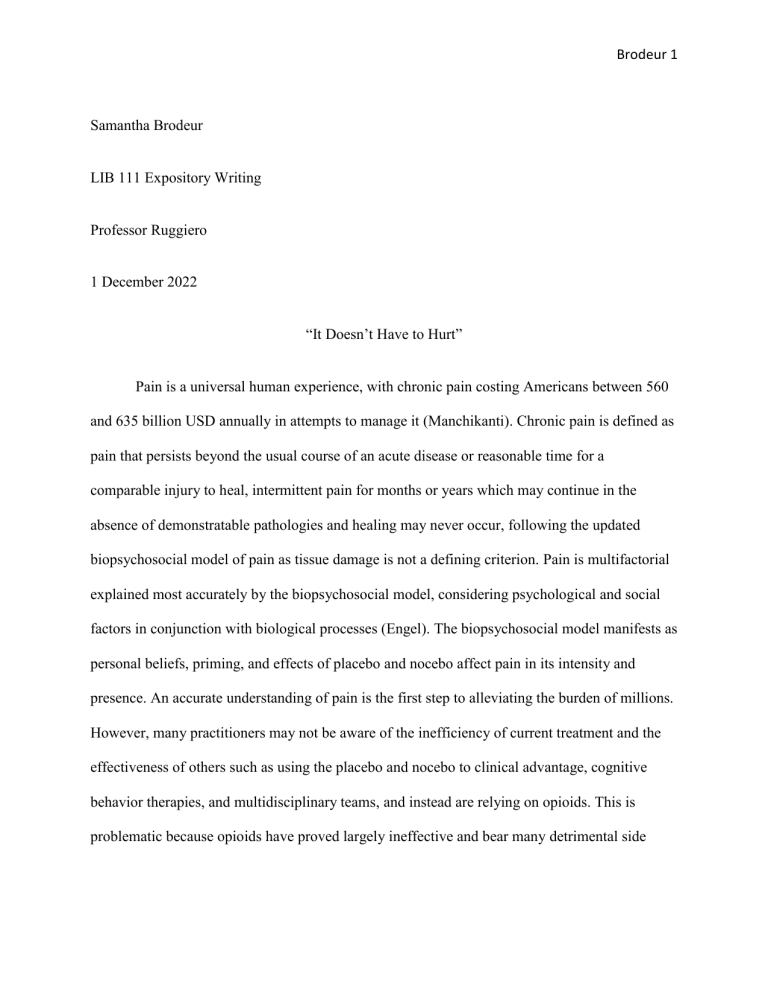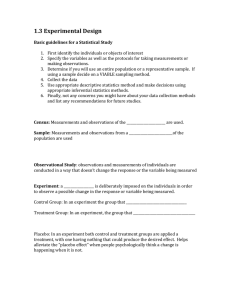
Brodeur 1 Samantha Brodeur LIB 111 Expository Writing Professor Ruggiero 1 December 2022 “It Doesn’t Have to Hurt” Pain is a universal human experience, with chronic pain costing Americans between 560 and 635 billion USD annually in attempts to manage it (Manchikanti). Chronic pain is defined as pain that persists beyond the usual course of an acute disease or reasonable time for a comparable injury to heal, intermittent pain for months or years which may continue in the absence of demonstratable pathologies and healing may never occur, following the updated biopsychosocial model of pain as tissue damage is not a defining criterion. Pain is multifactorial explained most accurately by the biopsychosocial model, considering psychological and social factors in conjunction with biological processes (Engel). The biopsychosocial model manifests as personal beliefs, priming, and effects of placebo and nocebo affect pain in its intensity and presence. An accurate understanding of pain is the first step to alleviating the burden of millions. However, many practitioners may not be aware of the inefficiency of current treatment and the effectiveness of others such as using the placebo and nocebo to clinical advantage, cognitive behavior therapies, and multidisciplinary teams, and instead are relying on opioids. This is problematic because opioids have proved largely ineffective and bear many detrimental side Brodeur 2 effects. A solution may be educating providers on such evidence-based therapies relying on the biopsychosocial model to understand pain. The presence of chronic pain is disabling as people are crippled by its impact on their daily lives. Chronic pain can be a permanent obstacle for people to live with, evident through the desperate expenditure of billions of dollars to manage it. Between 2003 and 2014, the National Violent Death Reporting System reported the percentage of people who died by suicide with evidence of chronic pain increased by 3% (Nazarov). Effective pain management is lacking and causing preventable deaths. In understanding the biopsychosocial model of pain, practitioners should be aware of the effects of the placebo, nocebo, priming, and beliefs. The placebo and nocebo behave as stimulus expectancies that influence brain markers of pain intensity processing in the brain (Atlas et al.). The placebo effect is defined as a beneficial effect produced by a placebo drug or treatment that cannot be attributed to the properties of the placebo itself and therefore must be a result of the patient's beliefs (Beecher). Responders to the placebo were reported as being more optimistic and less anxious than non-responders to the placebo (Atlas et al.). Responders showed strong neural markers of reward responsivity, higher levels of dopamine and opioid binding during pain stimulation, and larger grey matter density in the prefrontal cortex (Atlas et al.). As the opposite of the placebo effect, the nocebo effect is defined as the result of a negative outcome because of a belief that the intervention will cause harm (Wojtukiewicz). As the placebo response is associated with the emotional response of the patients; the nocebo response is associated with increased anxiety (Atlas et al.). Brodeur 3 Like the placebo and nocebo effect, the beliefs of patients before and during treatment largely dictate their outcomes. The patients understood pain as the biomedical model where they strongly associated structural changes with pain and disability (Bonfim). Because patients understood the biomedical model to explain their pain, fear avoidance was significant. Fearavoidance increased anxiety in patients and pain continued to dictate their lives possibly by a nocebo effect. Had the patients learned the biopsychosocial model of pain, would their pain have been relieved? Clinically, cognitive behavior therapies that involve changes in beliefs and attitudes toward pain can be effective (Altas et al.). With education on the complexities of pain and unlearning the biomedical model, patients can experience some relief. Practitioners also need to be aware of any possible priming they might cause the patient. Priming occurs when exposure to certain stimuli influences the response to a subsequent stimulus without an awareness of the connection (Ritter). It matters how providers communicate with patients and relay information about treatments as pain intensity is manipulated by the type of words used, even when the conversation is unrelated to the upcoming treatment (Vaegter). The treatment of pain is inadequate because many practitioners are not properly educated in the biopsychosocial model. Clinicians often prescribe opioids early in treatment due to minimal pain management education in medical school and residency programs, and little guidance for primary care physicians (Manchikanti). Although most prescribed, opioids have not proved effective. Evident through the vast spending on pain management, the increase of people reporting disabling pain, and the raising number of suicides due to pain, this quick fix is not cutting it. An epidemiological study of chronic opioid use in Denmark did not show any improvement in pain relief, functional capacity, or quality of life in patients with chronic pain Brodeur 4 (Chan). Against placebos, opioids are associated with marginal improvements (Effective Health Care Program). Even if patients are able to feel some relief on opioids, efficiency can decrease over time due to opioid-induced hyperplasia- tolerance- and dose escalation may be required to keep up with the pain, intensifying the side effects (Chan). Opioids have limited, if any, shortterm value for chronic pain, accompanied by significant abuse and side effects of depression, anxiety, panic disorders, and increased mortality rates (Chan). These side effects can become so detrimental that any relief patients may have felt on the opiate oftentimes does not out way the harsh side effects and many patients come off the drug. On the other hand, some patients can feel increased relief as they become addicted to the drug. Side effects continue accumulating as they approach abusing the drug and the possibility of an overdose. Presently there is no accurate tool for predicting opioid misuse, abuse, addiction, or overdose so the prescription remains highly risky (Effective Health Care Program). As American practitioners have limited education in pain management they turn to opioids. Opioids however lack the effectiveness and safety required for millions to relieve pain. The current treatment of pain is inadequate for the millions suffering. To alleviate the pain, practitioners need to prioritize treatments consistent with the biopsychosocial model rather than turning to the insufficient quick fix of opioids they are accustomed to. One alternative to prescribing opioids includes taking advantage of the placebo effect in the clinical setting. Under the biopsychosocial model, the placebo effect could be used to amplify the success of treatments. In clinical pain management, the placebo effect would function to strengthen the effects of therapies rather than being the attributed cause of improved symptoms as it is in the traditional placebo effect (Bystad et al.). As responders to the placebo effect were reported more optimistic and less anxious, practitioners can utilize this known correlation to Brodeur 5 optimize treatment efficacy (Atlas et al.). To manifest the placebo effect in clinical practice, a realistic hope must be built to influence the patient's expectations, and the patient's anxiety must be alleviated. Practitioners can accomplish alleviating patients’ anxiety by understanding their concerns and optimistically addressing them. These positively influenced expectations and comforted worries may activate the placebo effect. The patient may undergo a more successful treatment as a result of the elevated therapy, utilizing psychology in conjunction with biology. How clinicians frame information about the risks and benefits of treatments may influence the patient's perception. Practitioners should utilize optimistic language to optimize the patient’s outcome (Miller et al.). For clinicians to employ the placebo effect in their practice they should: describe the basic mechanics of the treatment, give accurate information stating that the particular treatment is effective, aim for an emotionally warm and empathetic style, and try to reduce the amount of stress for the patient (Bystad et al.). By catering to the unconscious psychology of the patient, the clinician may be able to access the patient’s own healing potential and produce a better outcome for them (Bystad et al.). As word choice is carefully chosen to be optimistic and the patient's stress is reduced, clinicians can employ the placebo effect with little risk of harm as the patient's psychology is optimistically manipulated. Clinical implications of the placebo effect in managing pain could manifest as therapies are amplified by the placebo effect. Existing therapies for pain management could be made more effective by employing optimistic expectations to activate the placebo effect. Evident through the billions in expenditure to manage pain, no current treatment is effective enough for the millions suffering but utilizing the placebo effect in treatments lacking exceptional efficiency could improve their outcomes and provide some relief. Brodeur 6 In contrast to employing the placebo, practitioners can do their best to suppress the nocebo effect in their treatments. The suggestion of adverse effects alone can cause them to manifest in patients, even in the absence of a biological basis (Colloca et al.). Aware of possible nocebo effects, clinicians can avoid its manifestation through regulated communication with the patient. Unlike utilizing the placebo, avoiding the nocebo effect in patients carries many risks including the informed consent of the patient. Practitioners may be hesitant to avoid the nocebo effect as they chance patients not understanding the risks of treatments and possible legal repercussions in battles of informed consent. Practitioners are protected however under the therapeutic privilege if they act in the best interest of the patient. Therapeutic privilege is the withholding of relevant health information if nondisclosure is believed to be in the best interest of the patient (Berg). While law and medical ethics endorse informed consent, practitioners have the therapeutic privilege to protect them if they feel the patient would benefit (Berg). The threat of the nocebo effect is justified as it is estimated to affect at least 25% of people in clinical trials, as placebo groups report adverse effects at the same rate as the treatment group (Wojtukiewicz). Since the nocebo effect poses a great risk to patients, practitioners are largely justified in employing the therapeutic privilege to minimize the adverse effects of treatment. Practitioners must use their best judgment as they balance minimizing the risk from intervention and the risks from information disclosure (Colloca et al.). Practitioners can use their understanding of the patient to dictate their course of action for risk disclosure. While practitioners must balance minimizing all risks, by understanding patient concerns and values practitioners can best treat the patient to their specific standards. In determining whether information should be withheld to mitigate the nocebo effect practitioners should listen to the values of the patient and their understanding of the treatment for the best care. By understanding the patient’s fears and the Brodeur 7 trade-offs they are willing to make the practitioner can make a judgment call on which treatment course best suits their values (Gawande). Employing a treatment aligned with the patient's values is important as patients who feel heard in their care plan may be less susceptible to the nocebo effect (Data- France et al.). In current therapies for pain management, such as acupuncture, where more pain is a risk, selective disclosure of the possibility of increased pain could lessen the number of patients experiencing the adverse effect. Utilizing the nocebo effect in the clinical setting may manifest on a case-to-case basis where understanding both the nocebo effect and the biopsychosocial model, practitioners can use their best judgment to decide what would be most beneficial to the patient. Although not widely studied yet, cognitive behavioral therapy could be combined with utilizing the placebo and mitigating the nocebo effect to act as a promising treatment in the management of pain. Cognitive behavioral therapy may be another nonopioid option for clinicians to use in pain management as it carries little risk but inconsistent results. Cognitive behavioral therapy may be inconsistent in treating pain because the certification of the therapy is inconsistent, and it has proven ineffective on people with mental disorders such as depression (U.S. Department of Health and Human Services). A person without depression and an effective clinician in cognitive behavioral therapy however may be able to effectively relieve chronic pain. In some studies, cognitive behavior therapy proved effective in changing the patient's expectations and mindset toward pain management aligning with the biopsychosocial model. One trial of cognitive behavior therapy proved to reduce the intensity of back pain by 43% (Sperry). In a similar study of patients with chronic low back pain, the meditation-cognitive behavioral therapy intervention was able to reduce both pain severity and sensitivity (Zgierska et Brodeur 8 al.). In another study of participants disabled by chronic low back pain, cognitive behavioral therapy was able to reduce disability but not pain (O’Keeffe et al.). The U.S. Department of Health and Human Services reported that the therapy improved coping skills, functional movement, sleep, and pain in patients. Although the therapy has not been able to produce consistent pain relief, with growing research on how to utilize the therapy there may be some promise for pain relief. With virtually no risks of adverse effects, cognitive behavioral therapy is a safe alternative to currently prescribed opioids. In conjunction with the utilization of the placebo effect and mitigating the nocebo effect, cognitive behavioral therapy may be an effective treatment for pain management. One known effective solution to pain is multidisciplinary teams. Multidisciplinary teams are medical professionals with complementary skills that work together to manage pain using the biopsychosocial model, ideally under one roof (U.S. Department of Health and Human Services). As the team approach proves beneficial to patients, the effectiveness was obvious of a cohesive team operating together under one roof. Multidisciplinary clinics were successful in managing pain in America during the 1980s as complicated chronic pain patients were more effectively treated by a team (U.S. Department of Health and Human Services). Multidisciplinary clinics housed these teams under academic centers, but the clinics were deprioritized as academic centers became increasingly concerned with profits (Tompkins). As American policy prioritized private profits over patient care, multidisciplinary clinics faced opposition. As the multidisciplinary clinics functioned as a team, they were largely unable to divide their services in a way for insurances to accept, and insurances rejected bills from the clinics, causing patients to have to pay out of pocket for multidisciplinary care (Tompkins). Unable to find patients capable Brodeur 9 of paying without the help of insurance, multidisciplinary clinics closed. Multidisciplinary clinics were successful in managing patients with chronic pain because they had interprofessional teams that prioritized the biopsychosocial model. While multidisciplinary clinics may never be as populous as they were before, practitioners can learn from what they succeeded in and apply it to their own practice. Practitioners can attempt to model this success by prioritizing working effectively with the patient and using the biopsychosocial model in evidence-based treatments to manage pain. Effective pain management is based on the biopsychosocial model of pain as the patient’s psychosocial considerations are prioritized. The biopsychosocial model provides the most accurate explanation of pain as psychosocial factors have proved a larger role in pain than biological tissue damage the biomedical model explains. The biopsychosocial model must be understood as it manifests in the placebo and nocebo effects, priming, and the beliefs of the patient as they prove significant to the patient’s experience of pain. Current pain management through the prescription of opioids has proved ineffective for both acute and chronic pain and instead, practitioners need to prioritize therapies consistent with the biopsychosocial model of pain as they prove safer and more effective. The placebo and nocebo effects may be successful for pain management in conjunction with existing therapies like cognitive behavioral therapy. Although complex, chronic pain has the potential to be relieved through increased clinician understanding of the biopsychosocial model and the patient. Brodeur 10 Brodeur 11 Works Cited “Opioid Treatments for Chronic Pain.” Opioid Treatments for Chronic Pain | Effective Health Care (EHC) Program, Apr. 2020, https://effectivehealthcare.ahrq.gov/products/opioidschronic-pain/research#:~:text=risk%20mitigation%20strategies.,Key%20Messages,appear%20to%20be%20dose%20dependent. Atlas, Lauren Y., and Tor D. Wager. “How Expectations Shape Pain.” Neuroscience Letters, vol. 520, no. 2, Elsevier BV, June 2012, pp. 140– 48. https://doi.org/10.1016/j.neulet.2012.03.039. Beecher, Henry K. “THE POWERFUL PLACEBO.” Journal of the American Medical Association, vol. 159, no. 17, American Medical Association (AMA), Dec. 1955, p. 1602. https://doi.org/10.1001/jama.1955.02960340022006. Berg, Jessica W. Informed Consent: Legal Theory and Clinical Practice. Oxford University Press, 2007. Bonfim, Igor da Silva, et al. “‘Your Spine Is so Worn Out’ – the Influence of Clinical Diagnosis on Beliefs in Patients With Non-specific Chronic Low Back Pain – a Qualitative Study’.” Brazilian Journal of Physical Therapy, vol. 25, no. 6, Elsevier BV, Nov. 2021, pp. 811–18. https://doi.org/10.1016/j.bjpt.2021.07.001. Burich, Molly. “The Changing US Reimbursement Landscape and Biosimilars.” Biosimilars, 2018, pp. 49–73., https://doi.org/10.1007/978-3-319-99680-6_3. Brodeur 12 Bystad, Martin, et al. “How Can Placebo Effects Best Be Applied in Clinical Practice? A Narrative Review.” Psychology Research and Behavior Management, 2015, p. 41., https://doi.org/10.2147/prbm.s75670. Chan, Bob Kwok Bun, et al. “Opioids in Chronic Non-cancer Pain.” Expert Opinion on Pharmacotherapy, vol. 12, no. 5, Informa Healthcare, Jan. 2011, pp. 705– 20. https://doi.org/10.1517/14656566.2011.536335. Colloca, Luana, and Franklin G. Miller. “The Nocebo Effect and Its Relevance for Clinical Practice.” Psychosomatic Medicine, vol. 73, no. 7, 2011, pp. 598–603., https://doi.org/10.1097/psy.0b013e3182294a50. Colloca, Luana, et al. “The Clinical Implications of Nocebo Effects for Biosimilar Therapy.” Frontiers in Pharmacology, vol. 10, 2019, https://doi.org/10.3389/fphar.2019.01372. Data-Franco, João, and Michael Berk. “The Nocebo Effect: A Clinicians Guide.” Australian & New Zealand Journal of Psychiatry, vol. 47, no. 7, 2012, pp. 617–623., https://doi.org/10.1177/0004867412464717. Engel, George L. “The Need for a New Medical Model: A Challenge for Biomedicine.” Dimensions of Behavior, 1978, pp. 3–21., https://doi.org/10.1016/b978-0409-95009-0.50006-1. Gawande, Dr. Atul. Being Mortal. MEHTA PUBLISHING HOUSE, 2018. Brodeur 13 Managing Chronic Pain in Adults with or in Recovery from Substance Use Disorders: Quick Guide for Clinicians. U.S. Dept. of Health and Human Services, Substance Abuse and Mental Health Services Administration, Center for Substance Abuse Treatment, 2013. Manchikanti, Laxmaiah, et al. “Lessons for Better Pain Management in the Future: Learning From the Past.” Pain and Therapy, vol. 9, no. 2, Springer Science and Business Media LLC, May 2020, pp. 373–91. https://doi.org/10.1007/s40122-020-00170-8. Miller, Franklin G., and Luana Colloca. “The Placebo Phenomenon and Medical Ethics: Rethinking the Relationship between Informed Consent and Risk–Benefit Assessment.” Theoretical Medicine and Bioethics, vol. 32, no. 4, 2011, pp. 229–243., https://doi.org/10.1007/s11017-011-9179-8. Nazarov, Oybek, et al. “Research Utility of the National Violent Death Reporting System: A Scoping Review.” Injury Epidemiology, vol. 6, no. 1, 2019, https://doi.org/10.1186/s40621-019-0196-9. O'Keeffe, Mary, et al. “Cognitive Functional Therapy Compared with a Group-Based Exercise and Education Intervention for Chronic Low Back Pain: A Multicentre Randomised Controlled Trial (RCT).” British Journal of Sports Medicine, vol. 54, no. 13, 2019, pp. 782–789., https://doi.org/10.1136/bjsports-2019-100780. Ritter, Alexander, et al. “How Words Impact on Pain.” Brain and Behavior, vol. 9, no. 9, Wiley, Aug. 2019, https://doi.org/10.1002/brb3.1377. Brodeur 14 Scherlinger, Marc, et al. “Switching from Originator Infliximab to Biosimilar CT-p13 in RealLife: The Weight of Patient Acceptance.” Joint Bone Spine, vol. 85, no. 5, 2018, pp. 561– 567., https://doi.org/10.1016/j.jbspin.2017.10.003. Sperry, Len. “Chronic Pain.” Treatment of Chronic Medical Conditions: Cognitive-Behavioral Therapy Strategies and Integrative Treatment Protocols., pp. 153–171., https://doi.org/10.1037/11850-011. Vaegter, Henrik Bjarke, et al. “Power of Words: Influence of Preexercise Information on Hypoalgesia After Exercise—Randomized Controlled Trial.” Medicine &Amp; Science in Sports &Amp; Exercise, vol. 52, no. 11, Ovid Technologies (Wolters Kluwer Health), May 2020, pp. 2373–79. https://doi.org/10.1249/mss.0000000000002396. Wojtukiewicz, Marek Z., et al. “It Is Not Just the Drugs That Matter: The Nocebo Effect.” Cancer and Metastasis Reviews, vol. 38, no. 1–2, Springer Science and Business Media LLC, June 2019, pp. 315–26. https://doi.org/10.1007/s10555-019-09800-w. Zgierska, Aleksandra E., et al. “Mindfulness Meditation and Cognitive Behavioral Therapy Intervention Reduces Pain Severity and Sensitivity in Opioid-Treated Chronic Low Back Pain: Pilot Findings from a Randomized Controlled Trial.” Pain Medicine, vol. 17, no. 10, 2016, pp. 1865–1881., https://doi.org/10.1093/pm/pnw006.






